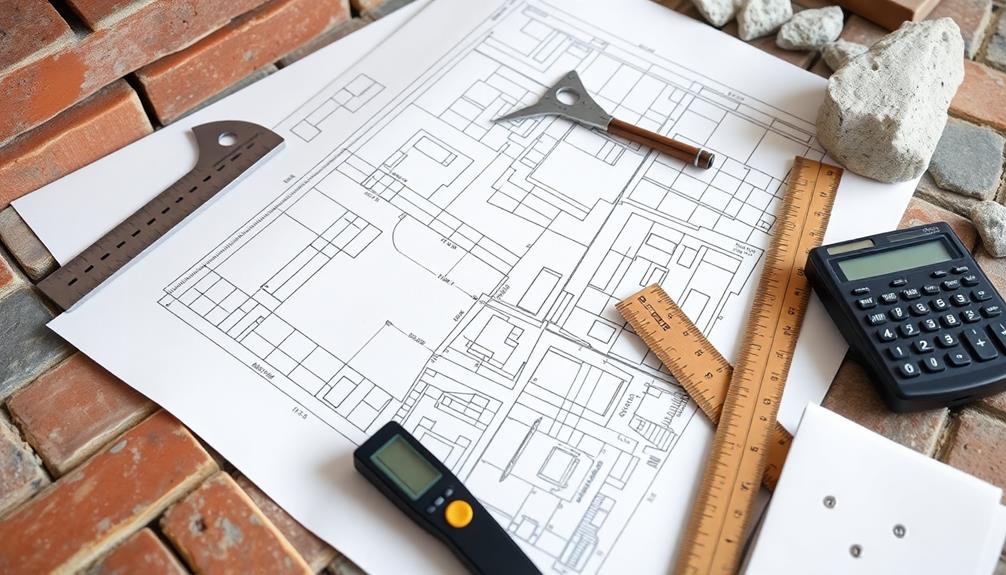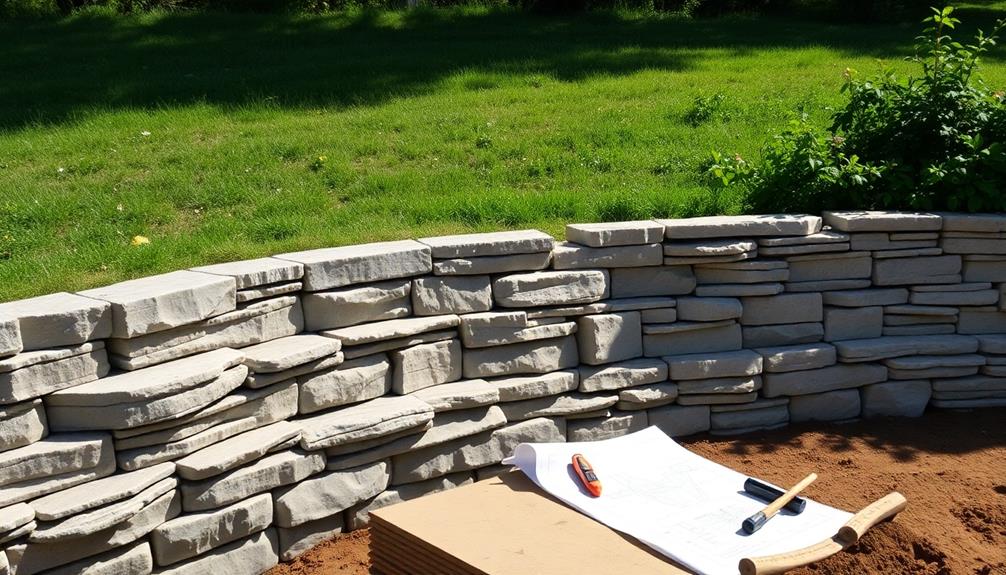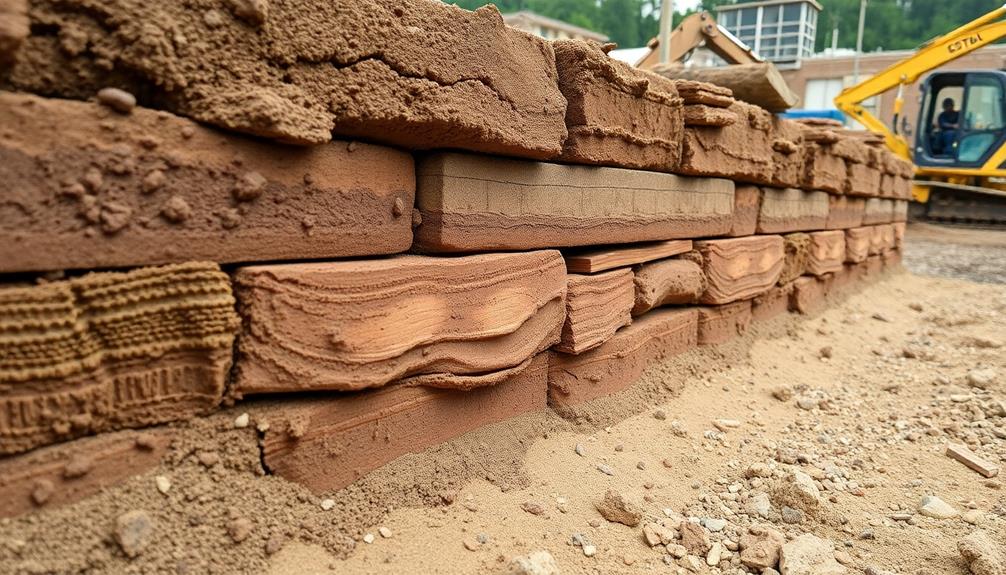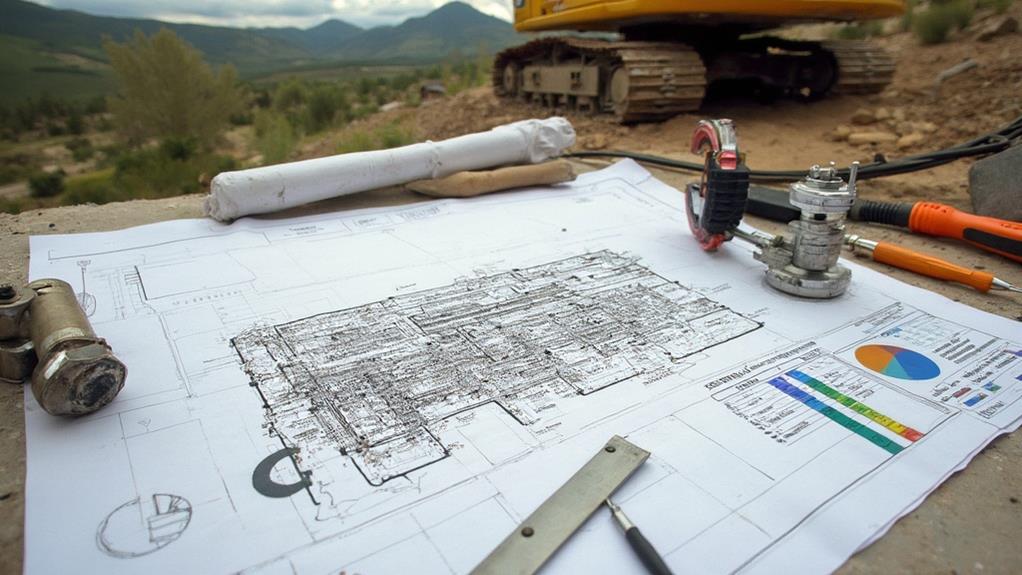Cost estimation is vital for retaining wall projects as it underpins effective budgeting and resource allocation, impacting structural stability and the project's financial success. Accurately evaluating key cost factors such as materials, labor, and site preparation allows for informed decision-making, helping to preempt unforeseen expenses. Estimation techniques like parametric and detailed estimates, when applied, provide clarity and align stakeholder expectations with financial realities, fostering collaboration. A thorough understanding of site-specific conditions, including soil type and drainage needs, is essential for tailoring solutions that enhance durability and safety. By exploring these dimensions, one can enhance project efficiency and success.
Table of Contents
ToggleWalls Contractor Highlights
- Accurate cost estimation ensures proper budgeting, aligning financial resources with project requirements.
- It helps identify potential financial risks early, reducing unexpected expenses during construction.
- Cost estimation allows for efficient resource allocation, optimizing labor and material deployment.
- Detailed cost estimates improve project timelines by anticipating and addressing potential hurdles.
- Effective cost estimation enhances collaboration and trust among stakeholders, guiding project success.
Definition of Cost Estimation

Cost estimation for retaining walls involves identifying and analyzing key cost factors, such as materials, labor, and site preparation, to accurately foresee the financial requirements of construction. Retaining walls, especially those using boulder retaining walls, require specialized installation expertise which impacts overall project costs.
An overview of estimation techniques, such as parametric and detailed estimates, allows stakeholders to choose the most suitable method based on project complexity and available data. The importance of accuracy in these estimates cannot be overstated, as it directly influences budgeting, resource allocation, and ultimately, project success.
Key Cost Factors
When undertaking the construction of a retaining wall, understanding key cost factors is essential for effective cost estimation. These factors encompass the project's complexity, material selection, labor requirements, site conditions, and regulatory considerations, which collectively dictate the project's budgetary needs. Each component plays a critical role in shaping the financial framework, ensuring stakeholders can align their objectives with the project's demands.
Complexity often dictates labor hours and specialized skills, requiring a detailed assessment of structural requirements and design intricacies. Material selection, too, a principal cost factor, involves choices between options like concrete, stone, or wood, each bringing distinct price tags influenced by sourcing and quality considerations.
Labor costs fluctuate depending on local wage standards and the expertise needed for project execution. Skilled craftsmen may demand higher remuneration, particularly where intricate or large-scale structures are involved. Additionally, site conditions, such as soil type and accessibility, can affect both labor and material expenditures, necessitating thorough site evaluations to anticipate potential challenges.
Estimation Techniques Overview
Effective budget management for retaining walls hinges not only on understanding key cost factors but also on employing precise estimation techniques. These methodologies are foundational, providing a structured framework through which project costs are anticipated, controlled, and ultimately realized. For those engaged in constructing retaining walls, accurate estimations serve as the blueprint that coordinates resources, aligns expectations, and enhances planning accuracy—establishing a common ground where stakeholders can confidently navigate project complexities.
Among the repertoire of estimation techniques, methodologies such as parametric, analogous, and bottom-up estimating play significant roles. Parametric estimating relies on statistical analysis, using historical data to extrapolate future costs, which is especially useful when dealing with repetitive or straightforward projects. Analogous estimating, on the other hand, leverages historical project data to draw parallels and infer costs from previous, similar projects, offering rapid insights though less precise than detail-intensive approaches. Bottom-up estimating, meanwhile, involves a meticulous breakdown of all project components into granular tasks, aggregating each task's cost to offer the most detailed prediction of total expenses.
In a community of industry professionals, these techniques foster a culture of preparedness and collaboration, ensuring that aspirations align with financial realities from inception to completion.
Importance of Accuracy
Achieving precision in cost estimation is a cornerstone of successful project management, especially in the context of constructing retaining walls. The process encompasses a detailed prediction of expenses associated with labor, materials, equipment, and other indirect costs, ensuring that budgets are meticulously planned and adhered to. Accurate cost estimation establishes a benchmark for evaluating actual expenditures, fosters financial discipline, and aids in mitigating unforeseen expenses which can jeopardize project feasibility.
In retaining wall construction, where structural integrity and durability are paramount, precise cost estimates also facilitate resource allocation and timeline adherence, directly influencing project outcomes and client satisfaction.
Cost estimation serves as an essential tool for maneuvering the complexities inherent in construction projects, where unexpected variances in material availability or price fluctuations can drastically alter the cost landscape. By incorporating data-driven models and historical data, estimators can construct a robust framework that anticipates potential financial risks, thereby aligning stakeholders and fostering a cohesive project environment.
Additionally, accurate cost estimation provides a transparent communication platform between contractors, clients, and suppliers, enhancing collaboration and trust. This alignment ultimately ensures that project goals are met efficiently, strengthening professional relationships and creating a shared sense of accomplishment within the construction community.
Benefits

The practice of precise cost estimation for retaining walls offers numerous advantages, chief among them being the facilitation of accurate budget planning, which guarantees that financial resources are allocated efficiently and project stakeholders are better prepared for the financial outlay involved.
Retaining walls, such as boulder retaining walls, not only help to create usable areas and prevent erosion but also boost curb appeal with their natural and unique appearance. By anticipating costs with greater accuracy, projects can allocate resources more effectively, thereby minimizing disruptions and reducing unexpected expenses that may arise from unforeseen budgetary shortfalls.
Additionally, a robust cost estimation process inherently supports improved project timelines, as it enables more predictable scheduling and resource management, ultimately leading to smoother execution and completion of the retaining wall construction.
Accurate Budget Planning
Accurate budget planning for retaining walls offers a myriad of benefits that extend beyond mere cost control. By establishing an extensive financial framework, project stakeholders can anticipate potential expenses with precision, allowing for informed decision-making throughout the project's lifecycle. This foresight enhances the ability to navigate financial constraints without compromising quality or timelines.
Additionally, having a well-defined budget cultivates a sense of trust and transparency among team members and clients, fostering a collaborative environment where everyone feels confident and secure in the project's financial scope.
Moreover, detailed budget planning contributes to mitigating unforeseen financial setbacks. By anticipating and accounting for variable costs, such as labor and materials, projects are better equipped to handle unexpected challenges without significant deviation from planned expenditures. This proactive approach minimizes the risk of project delays due to financial mismanagement, ultimately ensuring timely completion.
Furthermore, accurate budgeting strengthens relationships with contractors and suppliers by establishing clear financial expectations from the outset. This alignment reduces disputes and enhances cooperation, promoting a harmonious workflow. In a nutshell, precise budget planning not only safeguards the project's financial health but also reinforces the foundation of trust and collaboration essential for successful project execution.
Efficient Resource Allocation
Proper budget planning lays the groundwork for efficient resource allocation in retaining wall projects, underscoring its importance in the project's overall success. By meticulously forecasting costs, stakeholders can guarantee that each resource is effectively and judiciously allocated, preventing unnecessary waste and maximizing project potential. Resource allocation involves not merely the distribution of labor and materials, but the strategic deployment of specialized tasks aligned with project timelines and priorities.
In retaining wall projects, efficient allocation translates into aligning expert skills and materials with precise project phases, integrating them harmoniously to maintain momentum and quality. This coordination guarantees that skilled personnel focus on their areas of expertise, preventing bottlenecks and facilitating quality enhancements. Additionally, it affirms the community's shared values of collaboration and proficiency, creating a cohesive atmosphere where each contribution is valued.
With a clear picture of financial resources, project managers can prioritize aspects that demand immediate attention while reserving contingencies for unforeseen circumstances. Consequently, this planning nurtures a sustainable workflow, averting delays, and fostering shared confidence within the project team. Ultimately, efficient resource allocation reinforces a sense of belonging, where each participant's role is pivotal to the horizon of project completion and success.
Reduced Unexpected Expenses
Effective cost management substantially contributes to reducing unexpected expenses in retaining wall projects. Through accurate and detailed cost estimation, potential financial pitfalls are identified early, allowing stakeholders to make informed decisions that align with their project aspirations and resources. By anticipating variables such as material costs, labor expenses, and potential site challenges, project managers can develop a robust financial plan that minimizes surprises, thereby fostering a sense of security and reliability among team members and clients alike.
This proactive approach not only shields the project from unforeseen costs but also strengthens trust within the project community, ensuring that all involved parties feel valued and informed. As part of an extensive project strategy, cost estimation serves as a guiding tool that curtails financial risk, ensuring resources are allocated judiciously and efficiently.
Building a retaining wall involves intricate processes, each layer demanding precision and foresight; consequently, thorough cost management becomes indispensable. Ultimately, an accurately estimated budget becomes the keystone of project continuity, facilitating a harmonious workflow and enabling teams to deliver high-quality outcomes without undue financial strain. In this way, effective cost management is not merely a financial exercise but a catalyst for cohesive, successful project execution.
Improved Project Timeline
A well-structured cost estimation plan greatly enhances project timelines for retaining wall construction. By systematically analyzing every aspect of the project, from material procurement to labor deployment, cost estimation lays a foundation for a streamlined process.
Accurate estimation guarantees each phase is allocated precise timeframes, facilitating the coordinated arrival of materials and minimizing idle time. A detailed cost estimate consequently acts as a roadmap, allowing stakeholders to foresee potential hurdles and address them preemptively, leading to fewer disruptions in the workflow.
Embracing a thorough forecasting approach results in firm integration between project phases, driving efficiency and cohesion within teams. When project timelines are clear and realistic, professionals across various sectors can align their schedules, which fosters a deeper sense of community and shared purpose.
Collaboration among engineers, contractors, and suppliers becomes more seamless, as everyone operates from the same informed standpoint. Furthermore, this meticulous planning helps in achieving punctual project delivery, an essential quality for cultivating trust and credibility.
Clients who feel confident about a project's pace are more likely to feel an intrinsic connection to the collaborative mission, enhancing their sense of belonging and investment in the project's success.
Soil Type Considerations

The type of soil greatly influences the structural stability of a retaining wall, necessitating a thorough analysis of its physical properties to guarantee proper design and alignment with site-specific requirements. The permeability of various soil types dictates the drainage needs, which are essential in mitigating hydrostatic pressure and enhancing the wall's longevity. Cost implications are also evident, as different soil compositions can alter the material and engineering demands, underscoring the importance of accurate cost estimation based on soil variability.
| Consideration | Description |
|---|---|
| Structural Stability | Impact on wall design and reinforcement |
| Drainage Requirements | Importance of permeability and pressure relief |
| Cost Variation | Material and engineering cost differences |
Impact on Structural Stability
When planning the construction of retaining walls, understanding the impact of soil type on structural stability is paramount. Different soil compositions can markedly affect the durability and safety of retaining wall structures.
Coarse-grained soils, such as gravels and sands, typically offer better drainage and provide stable support for retaining walls. However, their load-bearing capacity depends on factors such as compaction and moisture content. Conversely, fine-grained soils like silts and clays can pose challenges due to their propensity for retaining water, resulting in increased lateral pressure against the wall, which might necessitate additional structural reinforcement.
Cohesive soils, while offering certain advantages such as resistance to erosion, can undergo significant volume changes due to moisture variation, influencing the stability of the wall. Understanding these physical properties is crucial not only to preempt potential structural failures but also to inform the all-encompassing cost estimation process. Ignoring soil characteristics could lead to underestimating the need for suitable foundation modifications or necessary supports, thereby risking the integrity of the entire project. By meticulously evaluating soil type impacts, project engineers and stakeholders can make informed decisions, ensuring that the retaining wall is both cost-effective and robust against environmental forces.
Drainage Requirements Analysis
In evaluating drainage requirements for retaining walls, particularly with respect to soil types, it is essential to ponder how varying soil properties influence water management strategies. Effective drainage is critical to maintaining the structural integrity and longevity of a retaining wall, and understanding the interplay between soil characteristics and drainage systems is indispensable for a successful project outcome.
Soil types such as clay, sand, and loam each present unique challenges and opportunities:
- Permeability: Different soil types have varying permeability rates. For example, sandy soils allow water to drain swiftly, reducing hydrostatic pressure on retaining walls, whereas clay soils retain water, increasing potential pressure buildup.
- Erosion Susceptibility: Understanding the erosive tendencies of soil is crucial. Loamy soils may require additional support to prevent erosion or washout, which might undermine the wall's foundation.
- Compaction: Compacted soils can noticeably reduce drainage capacity, necessitating tailored drainage solutions to prevent water accumulation and associated pressure.
- Settlement Potential: Variations in soil settlement can misalign drainage pathways. Clay, being prone to significant settlement, requires periodic adjustments to redirect water away from structural elements.
Collaborative analysis fosters well-informed decisions, guaranteeing robust drainage design tailored to specific soil conditions, aligning with broader project goals and community standards.
Cost Variation by Type
Although soil type may initially seem like a minor detail in construction budgets, it plays a significant role in influencing the overall cost of building retaining walls. The type of soil at a construction site affects stability, drainage, and the materials required for effectively anchoring a retaining wall. For instance, clay-rich soils, known for their poor drainage properties, may necessitate extensive drainage solutions, which inherently increase project costs.
Conversely, sandy soils, while more manageable in terms of drainage, might demand additional reinforcement to enhance stability and counteract their tendency to shift under pressure.
In considering the diverse characteristics of soil types, project planners must address these variables early in the cost estimation phase. This action guarantees that the chosen materials and construction techniques optimize both performance and budget. Engineers and architects, aware of the nuances of different soil compositions, wield their expertise to devise strategies that align technical requirements with fiscal constraints.
Walls Contractor FAQ
How Does Cost Estimation Impact the Project Timeline for Retaining Walls?
Accurate cost estimation directly influences a retaining wall project's timeline by ensuring resource allocation, prioritizing tasks effectively, and minimizing delays. By fostering collaboration and transparency, it cultivates a sense of shared mission among all project stakeholders.
What Tools and Software Are Commonly Used for Cost Estimation in Retaining Wall Projects?
Current industry standards often involve software tools such as PlanSwift, Bluebeam Revu, and Microsoft Excel for cost estimation in retaining wall projects. These platforms facilitate detailed analysis, fostering collaboration and ensuring accurate budget forecasting within project teams.
How Do Regulatory Requirements Influence Cost Estimation in Retaining Wall Projects?
Regulatory requirements substantially influence cost estimation by mandating compliance with safety standards and zoning laws, which can affect material selection, project timelines, and labor costs, thereby fostering a community-conscious approach to retaining wall project planning and execution.
Can Weather Conditions Affect Cost Estimation for Retaining Wall Construction?
Weather conditions markedly impact cost estimation in retaining wall construction by influencing material choice, construction timeline, and labor costs. Accurate forecasts allow project teams to anticipate challenges, promoting seamless execution and fostering a collaborative and successful working environment.
What Are Common Mistakes to Avoid During the Cost Estimation Process for Retaining Walls?
Avoid underestimating material quantities and overlooking site-specific challenges. Guarantee thorough analysis of labor costs and regulatory compliance. Engage experienced estimators to incorporate contingencies, fostering accurate projections that underpin successful collaboration and community satisfaction within retaining wall projects.







